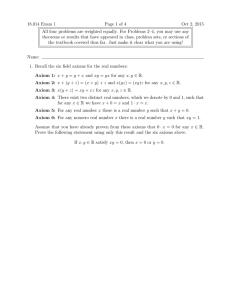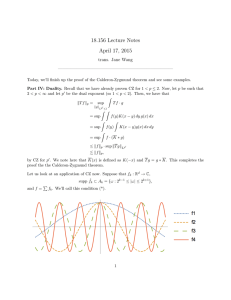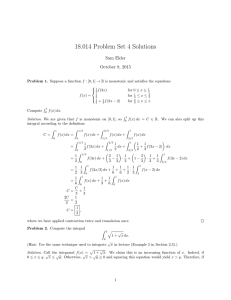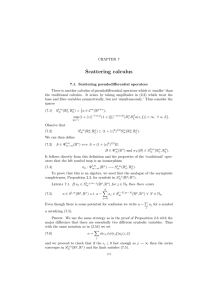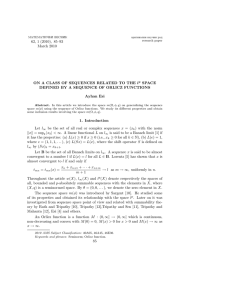18.014 Exam 1 Solutions Sam Elder October 8, 2015
advertisement
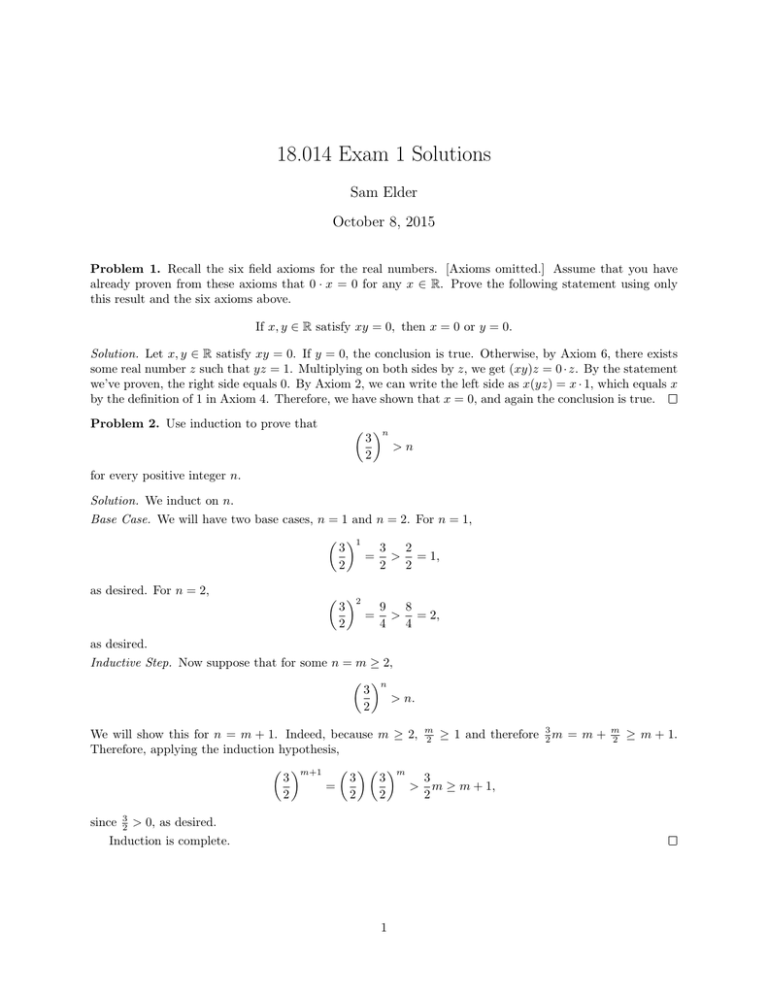
18.014 Exam 1 Solutions
Sam Elder
October 8, 2015
Problem 1. Recall the six field axioms for the real numbers. [Axioms omitted.] Assume that you have
already proven from these axioms that 0 · x = 0 for any x ∈ R. Prove the following statement using only
this result and the six axioms above.
If x, y ∈ R satisfy xy = 0, then x = 0 or y = 0.
Solution. Let x, y ∈ R satisfy xy = 0. If y = 0, the conclusion is true. Otherwise, by Axiom 6, there exists
some real number z such that yz = 1. Multiplying on both sides by z, we get (xy)z = 0 · z. By the statement
we’ve proven, the right side equals 0. By Axiom 2, we can write the left side as x(yz) = x · 1, which equals x
by the definition of 1 in Axiom 4. Therefore, we have shown that x = 0, and again the conclusion is true.
Problem 2. Use induction to prove that
n
3
>n
2
for every positive integer n.
Solution. We induct on n.
Base Case. We will have two base cases, n = 1 and n = 2. For n = 1,
1
2
3
3
= > = 1,
2
2
2
as desired. For n = 2,
2
3
9
8
= > = 2,
2
4
4
as desired.
Inductive Step. Now suppose that for some n = m ≥ 2,
n
3
> n.
2
We will show this for n = m + 1. Indeed, because m ≥ 2,
Therefore, applying the induction hypothesis,
m
2
≥ 1 and therefore
m+1 m
3
3
3
3
=
> m ≥ m + 1,
2
2
2
2
since
3
2
> 0, as desired.
Induction is complete.
1
3
2m
= m+
m
2
≥ m + 1.
Problem 3. For each of the following statements, S is a nonempty subset of the reals that is bounded both
above and below. Circle either T or F to indicate whether each statement is true or false. You do not need
to justify your answers.
Part 3.1. If every element of S is less than 1, then sup S is less than 1.
Solution. No. For a counterexample, consider the open interval (0, 1). Every element is less than 1, but its
supremum is 1, which is not less than 1.
Part 3.2. If inf S < x < sup S, then x ∈ S.
Solution. No. For a counterexample, consider the set {1, 2}. As a finite set, sup{1, 2} = max{1, 2} = 2 and
inf{1, 2} = min{1, 2} = 1. But 1 < 3/2 < 2 and 3/2 6∈ {1, 2}.
Part 3.3. If every element of S is an integer, then sup S is an integer.
Solution. This is true: Any such bounded S is finite, and the supremum of any finite set is equal to its
maximum, which will also be an element of the set and hence an integer.
Part 3.4. Let T = {x2 |x ∈ S} be the set of squares of elements of S. Then sup T = (sup S)2 .
Solution. This would be true if all of the elements of S were positive, but there is no such requirement. For
a counterexample, consider the set S = {−4, −2}. Then T = {(−4)2 , (−2)2 } = {4, 16}. As before for finite
sets, we have sup S = max S = 2 and sup T = max T = 16 6= 22 .
Part 3.5. If sup S = 3, then there exist x ∈ S with 2.9 < x ≤ 3.
Solution. This is true: By Theorem I.32(a) in the book with h = 0.1, there exists some x ∈ S with x > 2.9.
But sup S = 3 is an upper bound for all elements in the set, so x ≤ 3, and we have 2.9 < x ≤ 3 as desired.
Part 3.6. If max S exists, then sup S = max S.
Solution. This is true: If max S exists, then it is indeed an upper bound for every element in the set, and
no smaller number is an upper bound for it, so it satisfies the definition of the least upper bound.
Problem 4. Define a function f : [10, 40] → R by f (x) = x1 .
Part 4.1. Prove that f is integrable.
Solution. Since 0 6∈ [10, 40], f is defined on all of [10, 40]. Moreover, for all 10 ≤ x < y ≤ 40, x, y > 0 so
by a homework problem, f (y) = y1 < x1 = f (x). This shows that f is monotonically decreasing, so f is
integrable.
Part 4.2. Prove that
1
≤
2
Z
20
f (x) dx ≤ 1.
10
1
1
Solution. Define the constant functions s, t : [10, 20] by s(x) = 20
and t(x) = 10
for all x ∈ [10, 40]. We
1
showed in the first part that f (x) is decreasing, so for all x ∈ [10, 20], f (x) ≤ f (10) = 10
= t(x) and
1
f (x) ≥ f (20) = 20 = s(x). In other words, we have s(x) ≤ f (x) ≤ t(x) for all x ∈ [10, 20]. Therefore, by the
Comparison Theorem,
Z 20
Z 20
Z 20
1
1
1
= (20 − 10)
=
s(x) dx ≤
f (x) dx ≤
t(x) dx = (20 − 10)
= 1.
2
20
10
10
10
10
Part 4.3. Prove that
Z
40
1≤
f (x) dx ≤ 2.
10
2
Solution 1. Define the step functions s, t : [10, 40] by
(
1
if 10 ≤ x ≤ 20
s(x) = 20
1
if 20 < x ≤ 40;
40
(
t(x) =
1
10
1
20
if 10 ≤ x ≤ 20
if 20 < x ≤ 40.
Notice that these definitions agree with the definitions from the previous part on [10, 20]. Therefore, we
know that s(x) ≤ f (x) ≤ t(x) for 10 ≤ x ≤ 20, and it remains to show this on (20, 40].
1
1
1
and t(x) = 20
. Again since f is decreasing, f (x) ≥ f (40) = 40
= s(x) and f (x) ≤
There, s(x) = 40
1
f (20) = 20 = t(x). Therefore, we have shown that s(x) ≤ f (x) ≤ t(x) for all x ∈ [10, 40].
Now we compute the integrals as before. By the definition of the integral of a step function,
Z 40
1
1
1 1
s(x) dx = (20 − 10) + (40 − 20)
= + =1
20
40
2
2
10
Z 40
1
1
t(x) dx = (20 − 10) + (40 − 20)
= 1 + 1 = 2.
10
20
10
Therefore, by the Comparison Theorem,
Z 40
Z
1=
s(x) dx =
10
40
Z
40
f (x) dx =
10
t(x) dx = 2,
10
as desired.
Solution 2. The clever approach: We manipulate this integral into two copies of the previous one. First we
split it at 20:
Z 40
Z 20
Z 40
f (x) dx =
f (x) dx +
f (x) dx.
10
10
20
Now we contract the second copy by a factor of 2. By contraction (Theorem 1.16 with k = 21 ),
Z
40
Z
20
f (x) dx = 2
20
Z
20
f (2x) dx = 2
10
10
1
dx =
2x
Z
20
10
2
dx =
2x
Z
20
10
1
dx =
x
Z
20
f (x) dx,
10
where we have applied linearity (Theorem 1.191 ) to move the 2 inside the integral. Therefore, we have shown
R 40
R 20
that 10 f (x) dx = 2 10 f (x) dx, so doubling the inequality from the previous part gives
Z
40
1≤
f (x) dx ≤ 2,
10
as desired.
1 Of course, students aren’t expected to memorize these theorem numbers, but we provide the references as a reminder of
what these results say in general.
3
